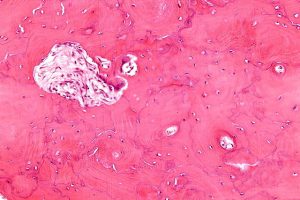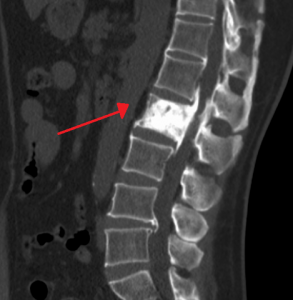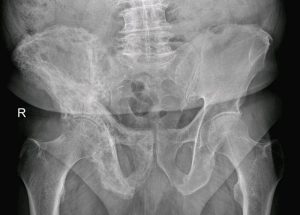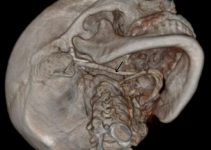What is Paget’s Disease of Bone
Page Contents
- 1 What is Paget’s Disease of Bone
- 2 What Causes Paget’s Disease of the Bone
- 3 Risk Factors
- 4 Signs and Symptoms
- 5 Complications
- 6 Diagnosis and Tests
- 7 Differential Diagnosis
- 8 Treatment and Management
- 9 Prognosis
- 10 Incidence and Prevalence
- 11 Living with Paget’s Disease: Self-Management for Preventing Recurrence
- 12 ICD-9-CM and ICD-10-CM Codes
Osteitis deformans, better known as Paget’s disease, is a chronic disorder characterized by disruption of normal renewal process of bones, where old or mature bone tissues are replaced by new ones. Named after Sir James Paget, the localized disease causes the ‘osteoclasts’ bone cells to absorb bones faster than normal. As a result, bone cells called ‘osteoblast’ overreact by making excess bone, resulting in softening and deformity of the affected bones.
People usually have Paget’s disease in their skull, collarbones, spine, temporal bones, and in proximal long bones of arms, hips, and thighs.
What Causes Paget’s Disease of the Bone
Although there is no conclusive evidence, researchers believe that genetic, as well as environmental factors, are responsible for its occurrence. A few studies have shown alterations in some genes including SQSTM1/p62 and RANK are associated with its development.
Some researchers think that infections caused by measles, canine distemper, and respiratory syncytial virus might contribute to this disease, although this theory has been largely debated.

[1]Micrograph showing Paget’s Disease of the bone with the characteristic jigsaw puzzle-like/mosaic pattern
Risk Factors
- Age: Older people are mostly at risk for Paget’s disease of bone.
- Origin: It commonly occurs in people from Greece, Scotland, England, and Central European countries. It is rare in Asia and Scandinavia.
- Family history: It is seen in those whose family members had suffered from the health condition in the past.
- Gender: Men are more likely to be affected than women.
Signs and Symptoms
Paget’s disease is normally asymptomatic, but sometimes symptoms may occur, with patients complaining of:
- Tingling, numbness, and pain in bones and joints
- Misshapen bones such as deformed legs, curved spines, and enlarged skull
Complications
Paget’s disease is often associated with a higher risk of:
- Arthritis caused by an increased amount of stress on joints
- Fractures due to weakening of bones
- Heart disease caused by hard-working heart muscles, which may result in high-output congestive heart failure
- Kidney stones due to an increased calcium deposits in the body
- Hearing loss, headaches, or vision loss in people with Paget’s disease of the skull
- Problems with nervous system
- Bone cancer
- Abdominal pain, constipation, loss of appetite, weakness, or fatigue caused by an elevation of calcium levels in blood due to overactive bone resorption
- Paralysis of lower body (paraplegia)
Diagnosis and Tests
An early diagnosis is essential to avoid the life-threatening complications. A physical examination of the affected areas is usually followed by blood tests and imaging tests for the detection of Paget’s disease.
Imaging Tests (Radiology)
- X-ray images of the affected bone can indicate abnormalities such as an increase in density, enlargement, and deformity in shape. In the initial stages, a hole appears in the bone due to overactive resorption. Over time, it turns into a “V” shaped area with denser bone appearing behind it.
- Bone scan, done by injecting a radioactive material into a vein, shows the areas with an unusual bone turnover as “hot spots.”
- Computerized tomography scan (CT scan) can show a detailed 3D image of the affected bone.
- Magnetic resonance imaging scan (MRI scan) uses a magnetic field along with radio waves to produce a clear image of the bones involved.
Blood Test
Paget’s disease can be confirmed with a blood test since a person with Paget’s disease usually has high levels of serum alkaline phosphatase in blood. Moreover, a complete blood count (CBC) indicating anemia points to Paget’s disease.
Bone Biopsy
A small bone marrow sample is collected after local anesthesia, to be tested in a medical lab.
Differential Diagnosis
- Osteoporosis
- Osteoarthritis
Treatment and Management
Controlling the over-activity of bone cells and minimizing progression of the symptoms are the primary objectives of treatment.
Medication
- Bisphosphonates, like alendronate, risedronate, ibandronate, zoledronic acid, etidronate, tiludronate, and pamidronate restrain bone resorption, helping in bringing down alkaline phosphatase levels to a normal state. However, bisphosphonate therapy can possibly increase the chances of severe pain in bones, joints, and muscles, and a condition of jawbone called osteonecrosis of the jaw.
- Calcitonin injections or sprays, like salmon calcitonin is prescribed in cases where bisphosphonates are not well tolerated. Administered by nasal spray or injection, calcitonin helps in regulating calcium levels in the body, and thus keeps bone resorption in check. It may have several side effects including facial flushing, and nausea.
- Nonsteroidal anti-inflammatory drugs such as acetaminophen may help lessen pain.
Surgery
When further complications such as deformities, fractures, or severe osteoarthritis develop, surgery is needed to:
- Realign deformed bones
- Remove and replace damaged hips and joints
- Reduce pressure on a compressed nerve by moving bones away from it
- Realign bones to help fractures heal
Since surgery involving the affected bones has a risk of excessive blood loss, patients are given medications that are directed towards reducing disease activity.
Alternative Treatment
Occupational therapy or physiotherapy can be useful for reducing pain and improving the range of movement.
When no symptoms occur and blood tests do not show any abnormal increase in bone-specific serum alkaline phosphatase (BSAP) level, no treatment is necessary.
Prognosis
In mild to moderate cases, Paget’s disease can improve if a patient is diagnosed and treated before the occurrence of major changes in bones. However, improvement is less likely if the person has any kind of malignant transformation including sarcomatous degeneration. The five-year survival rate for those with malignant tumor along with Paget’s disease is 5-7.5%.
Incidence and Prevalence
Recent surveys have shown that Paget’s disease of bone affects about 1-3 million people in the USA. Its prevalence is 2.3% in people belonging to the 65-74 year old age group. It occurs in 10% of individuals over 80 years old and 1-3% of population between 45 and 55 years.
It is also common in the UK, New Zealand, Australia, South Africa, France, and Germany. It affects 4.6% of elderly population in England, 2.4% in France, 3-4% in New Zealand and Australia.
Living with Paget’s Disease: Self-Management for Preventing Recurrence
Consult a medical practitioner to know ways about keeping your bones healthy. You can follow some simple steps:
- Following a diet offering 1,200 mg calcium and more than 400 IU vitamin D to keep bones strong.
- Regular exercise for maintaining skeletal health and joint mobility.
- Using walking sticks, frames, splints, or braces to support bones and joints, and prevent falling.
- Taking vitamin D and calcium supplements to improve bone health.
- Trying relaxation techniques to minimize stress on your affected bones.
ICD-9-CM and ICD-10-CM Codes
The ICD-9-CM code for Paget’s disease of bone is 731.0, and the ICD-10-CM code is M88.




I loved your article and found useful information.
from now on I will follow your advice i.e Taking vitamin D and calcium supplements to improve bone health.
Thanks